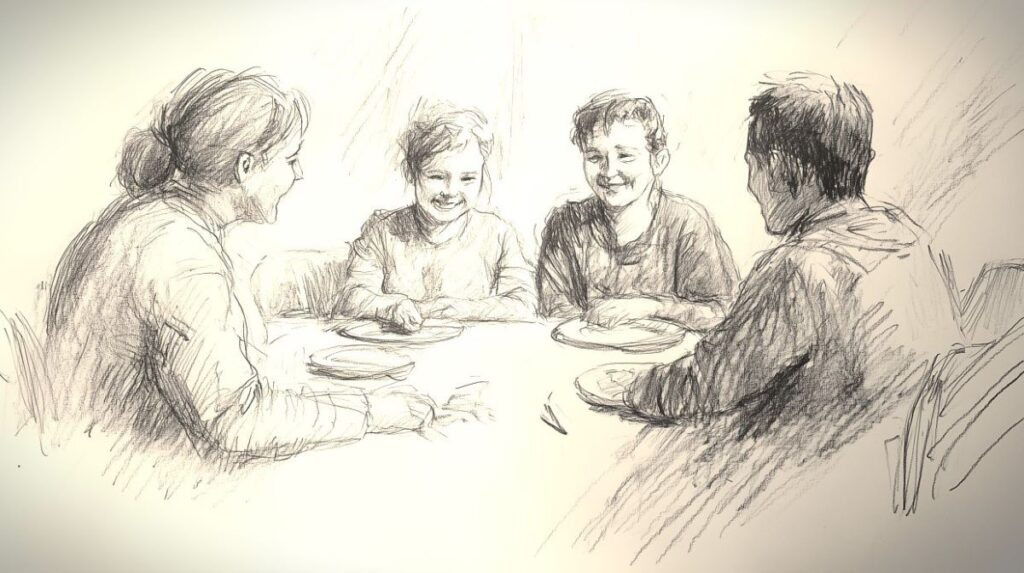Family Foundations: Embracing Natural Living, Nourishment, and Togetherness
As a loving mother and homemaker, you have a high calling, setting the tone for your home and shaping your family’s lifestyle.
- Creating a Culture of Love, Humility, and Unity in Your Family
- Incorporating Fun and Adventure in Family Activities
- Finding a Balance between Housework, Homeschooling, and Family Life
- Exploring the Outdoors: Hiking, Fishing, and Outdoor Adventures
- A Holistic and Natural Approach to Healthy Diet and Nutrition
- Fostering Creativity in Your Children: Simple Ideas for Encouraging Imagination and Innovation
- The Benefits of Homeschooling: Why More Families are Choosing to Educate at Home
- Raising Compassionate and Empathetic Children
- The "Shelter" Myth: Why Sheltering Your Children Is Actually Good Parenting
- Understanding the Concept of Shelter
- The Role of Parents as Shelters
- Why Sheltering Is Beneficial
- Reclaiming the Concept of Sheltering
- Building Strong Family Bonds: Communication, Conflict Resolution, and Quality Time
- Open Communication: The Heartbeat of a Family
- Conflict Resolution: Building Bridges, Not Walls
- The Art of Civil Disagreement
- Applying Good Judgement in Disagreements
- Quality Time: The Fabric That Binds Families Together
- The Opportunity of a Lifetime: A Legacy of Love
The key roles you play are irreplaceable and contribute to the overall well-being of the ones you love. Embracing natural living, family nourishment, and togetherness will immeasurably enrich your family’s life.
- Embracing Natural Living: Incorporating natural elements into your family’s daily routine can teach your children to value health at a young age while also appreciating the beauty and utility of things around them.
- Nourishment: Providing nutritious meals is not just about satisfying hunger but also about promoting healthy eating habits that will last a lifetime.
- Togetherness: Encouraging shared activities can strengthen family bonds and create lasting memories.
Love begins in the home.
Creating a Culture of Love, Humility, and Unity in Your Family
How do we cultivate a culture of love, humility, and unity within our families? It starts with modeling these values ourselves. Remember, we are our children’s first teachers. Our actions, words, and attitudes set the tone for our household. Show love through daily acts of kindness, exercise humility by admitting when you’re wrong, and promote unity by prioritizing family time above all else. While it’s not always easy, the rewards are immeasurable.
The answer lies in integrating certain practices into our daily lives that reinforce these values. Here are a few practical examples:
- Regular Family Meals: Shared meals foster unity and provide a platform for open communication. Discussions over dinner can often lead to deeper understanding and expressions of love and humility.
- Group Activities and Outings: Participating in activities as a family, like going for a hike or playing a board game, encourages teamwork and a sense of belonging, thereby promoting unity and mutual respect.
- Daily Reflections and Gratitude: Encourage each family member to share their daily highs and lows and something they’re grateful for. This practice nurtures an environment of appreciation, humility, and understanding.
- Resolving Conflicts with Honesty, Love, and Humility: Teaching children to face conflicts with empathy, forgiveness, and humility helps develop a loving and supportive familial atmosphere.
Incorporating Fun and Adventure in Family Activities
Family activities should be more than just obligations—they should be fun and adventurous! Whether it’s a backyard camping trip, a creative DIY project, or a spontaneous dance party, making time for joy and laughter strengthens family bonds. Remember that it’s not about what you do, but rather, how you do it. Turn ordinary routines into extraordinary memories and watch the fun unfold. Embrace the beauty of natural living, let it nourish your soul, and foster togetherness in your family.
Family time is sacred, a chance to forge deeper connections and create unforgettable memories. But how can we inject more fun, adventure, and excitement into these precious moments? Here are some ideas that will get those creative juices flowing, inspiring you and your family to embrace the thrill of new experiences.
- Exploring the Great Outdoors: Whether it’s hiking, camping, or just a picnic in your local park, there’s nothing quite like the fresh air and natural beauty of the great outdoors to bring families together.
- Learning Something New: From cooking classes to art workshops, there is a world of knowledge waiting to be discovered. Learning something new as a family not only expands your horizons but also strengthens your bonds.
- Going on a Road Trip: There’s nothing quite as thrilling as hitting the open road. Plan out an itinerary that includes fun stops and interesting sights. The journey can often be as enjoyable as the destination.
- Embarking on a DIY Project: This could be anything from building a treehouse to setting up a vegetable garden. Not only does this foster creativity, but it also instills a sense of accomplishment and teamwork.
- Organizing a Game Night: Whether it’s board games, card games, or video games, game nights are a fantastic way to foster healthy competition and lots of laughter.
- Planning a Movie Marathon: Choose a theme, load up on popcorn and snacks, and spend the day or night watching your favorite movies together.
- Volunteering Together: Spend time helping out at a local charity or community event. This not only feels good but also teaches your children valuable lessons about giving back.
Remember, the goal is not to fill every moment with activity but to create opportunities for joy, discovery, and togetherness. So embrace adventure, cultivate curiosity, and, most importantly, have fun as a family!
Finding a Balance between Housework, Homeschooling, and Family Life
Striking a balance between housework, homeschooling, and family life can often feel like juggling too many balls at once. But don’t worry; it’s achievable with a little planning and flexibility. Prioritize tasks, create a routine, delegate chores, and remember to take breaks. Most importantly, let go of perfection. Some days will be messier than others, and that’s okay because, in the grand scheme of things, love and togetherness are what truly matter.
Prioritize Tasks
Understand what needs your attention immediately and what can wait. Is it essential to clean the kitchen right after breakfast, or can it wait until after the home-schooling session? The key is to identify what’s urgent and important and what’s not. Once you’ve figured that out, you can plan your day accordingly.
Create a Routine
Having a routine brings structure and predictability to your days. But remember, a routine doesn’t mean your day needs to be planned down to the last minute. It’s more about creating a rhythm that your family can flow with. Flexible routines can make homeschooling and home management smoother without making life feel too regimented. So, be creative and flexible when it comes to establishing your family routine!
Delegate Chores
There is absolutely no reason why you should shoulder all the housework yourself. Assign responsibilities to everyone in the house according to their age and capabilities. This way, you are not only sharing the workload but also teaching your children valuable life skills. Remember, teamwork makes the dream work!
Take Breaks
It’s easy to get caught up in the whirlwind of tasks and forget that you, too, need a break. Every now and then, make sure you take some time for yourself. Read a book, go for a walk, stretch, or just sip a cup of tea in silence. It’s essential to take care of your own well-being so you can take care of your family’s.
Let Go of Perfection
There’s no such thing as a perfect home, a perfect meal, or a perfect lesson plan. There will be days when the laundry piles up, the dishes are not done, or the homeschooling session doesn’t go as planned. On such days, take a deep breath and remind yourself that it’s okay. Love and togetherness are more important than perfection.
Exploring the Outdoors: Hiking, Fishing, and Outdoor Adventures
Exploring the great outdoors is not only a wonderful way to create lasting family memories, but it also offers numerous health benefits. Hiking, fishing, and outdoor adventures can help reduce stress, improve physical fitness, and foster a love for nature in your children. Remember, the best classroom is roofed only by the sky. So why not step outside and transform the world into your playground?
Benefits of Outdoor Activities for Families
Getting outside and immersing in the beauty of nature is a powerful antidote to our often busy and technology-filled lives. But what are the specific benefits families can reap from engaging in outdoor activities? Let’s delve into it.
- Boosts Physical Health: Outdoor activities, whether it’s a simple walk in the park or a strenuous hike, can greatly improve your family’s overall physical health. It enhances cardiovascular fitness, builds strong bones, reduces obesity risk, and boosts the immune system. You’re not just burning calories; you’re building a healthier, happier family.
- Enhances Mental Well-being: Spending time outside, under the sky, reduces stress and anxiety. Nature has a calming effect on our minds; it’s a natural therapy that can uplift our mood, increase creativity, and improve focus and memory. It’s a breath of fresh air for the mind, isn’t it?
- Nurtures Love for Nature: Outdoor activities can foster a deep appreciation for nature in your children. It offers them a hands-on experience of the environment, teaching them about local plants, animals, and ecosystems. This can plant the seed for environmental stewardship in their hearts, and can you think of a better lesson to pass on? Embracing outdoor activities as a family can bring forth a myriad of benefits.
With all these benefits in mind, there’s an unsettling yet relative truth that needs to be addressed. Childhood obesity is a growing concern globally, and it’s high time we acknowledge this alarming issue. Let’s take a look at some facts that might just be the wakeup call we need to take action:
Alarming Statistics on Childhood Obesity
| Fact | Statistic |
|---|---|
| Global Prevalence | According to the World Health Organization, the number of obese children and adolescents worldwide has risen tenfold in the past four decades. |
| Obesity in the US | The Centers for Disease Control and Prevention states that in the United States, the prevalence of obesity was 19.3% and affected about 14.4 million children and adolescents in 2017-2018. |
| Long-Term Impact | Studies indicate that children and adolescents battling obesity are likely to stay obese into adulthood and more likely to develop noncommunicable diseases like diabetes and cardiovascular diseases at a younger age. |
| Socio-economic Impact | According to the American Heart Association, 1 in 3 American kids and teens is overweight or obese, nearly triple the rate in 1963. Among children today, obesity is causing a broad range of health problems that previously weren’t seen until adulthood. |
| Prevention | According to the American Heart Association, 1 in 3 American kids and teens is overweight or obese; nearly triple the rate in 1963. Among children today, obesity is causing a broad range of health problems that previously weren’t seen until adulthood. |
Childhood obesity is an all too common issue we can no longer afford to ignore. It’s time we take proactive measures to protect our children’s health, and create a more active, healthier lifestyle for our families.
So, let’s get outside, get active, and enjoy the benefits of natural living together as a family. Your family’s health is important and you are directly responsible for the diet and weight gain of your children. Get your family outside and enjoy the outdoors together!
Outdoor Activities to Try as a Family
Feeling a bit overwhelmed about where to start with outdoor activities? I’ve got a chest full of exciting, engaging outdoor activities that I’m sure your family will absolutely adore.
Here are some ideas for fun, engaging outdoor activities your family will love.
| Outdoor Activity | Benefits | Appropriate Age Group |
|---|---|---|
| Family Walks | Improves cardiovascular fitness, helps in weight management, and strengthens bones. | All ages |
| Hiking | It enhances motor skills, increases understanding of the natural world, and helps reduce stress levels. | 6 and above |
| Gardening | Enhances motor skills, increases understanding of the natural world, and helps reduce stress levels. | Four and above |
| Cycling | Improves balance, agility, and coordination while also burning calories. | Five and above |
| Picnicking | Encourages healthy eating, promotes family bonding, and offers relaxation amidst nature. | All ages |
| Fishing | Improves focus and patience, provides a source of nutrition, and enhances appreciation for aquatic ecosystems. | Five and above |
| Camping | Improves survival skills, promotes physical activity, and deepens understanding of the environment. | Eight and above |
| Swimming | Improves cardiovascular health, builds muscle strength, and enhances coordination and balance. | Four and above |
| Rock Climbing | Boosts physical strength, enhances problem-solving skills, and builds self-confidence. | Eight and above |
| Roller Skating | Improves balance, agility, and coordination, while also burning calories. | Five and above |
| Kite Flying | Enhances hand-eye coordination, encourages creativity, and can be a source of relaxation. | Four and above |
| Tree Planting | Promotes environmental responsibility, helps reduce CO2 in the atmosphere, and improves soil quality. | Five and above |
| Sandcastle Building | Enhances creativity, boosts fine motor skills, and can be a source of relaxation and fun. | All ages |
| Star Gazing | Promotes an interest in astronomy, encourages curiosity, and provides opportunities for relaxation and wonder. | All ages |
| Scavenger Hunts | Provides fun physical activity, improves problem-solving skills, and encourages teamwork. | Four and above |
Remember, the aim is not just to keep busy, but to engage meaningfully with the environment and each other. So, which activity will you and your family embrace next? Remember, every step taken outside is a step towards health, happiness, and a more profound appreciation of our beautiful world.
The goal isn’t to be perfect. It’s about spending quality time together, enjoying the beauty of nature, and creating lasting memories. So, are you ready to step outside and embrace the joys of natural living?
A Holistic and Natural Approach to Healthy Diet and Nutrition
When it comes to nourishing your family, a holistic and natural approach is the key to unlocking a world of wholesome goodness. But what does this entail? It means embracing foods in their most natural state, avoiding processed alternatives, and recognizing the innate connection between what we eat and our overall health. It’s about creating meals that are not just delicious but also nutritious, an act of love that nourishes the body, mind, and soul of your loved ones.
- Whole foods: Look for unprocessed, unrefined, or minimally processed foods. This includes fruits, vegetables, legumes, whole grains, lean proteins, and healthy fats.
- Seasonal and local: Eating locally sourced, in-season produce means your food is more likely to be at its peak in terms of flavor and nutrition. It’s also a wonderful way to support your local farmers and reduce your carbon footprint.
- Nutrient density: Make every bite count by choosing foods that offer a high nutritional value relative to their caloric content. This is particularly important for children, who need an array of nutrients for their growth and development.
The beauty of a holistic approach to nutrition is that it’s flexible and adaptable to suit every family’s unique needs and preferences. You’re not bound by strict rules or one-size-fits-all meal plans. Instead, it’s about making conscious, informed decisions about what you choose to put on your family’s plate.
It’s about making small, sustainable changes that add up over time. Set a positive example for your children and teach them the importance of nourishing their bodies with wholesome foods.
Fostering Creativity in Your Children: Simple Ideas for Encouraging Imagination and Innovation
Encouraging creativity in your children is key to their cognitive, social, and emotional development. Offer various creative outlets, such as arts and crafts, music, and imaginative play. Equally important is the freedom to make mistakes—creativity thrives when we are unafraid to fail. So, let’s cultivate an environment where imagination and innovation are celebrated, shall we?
C.R.E.A.T.E: Fostering Creativity in Your Children
If you’re wondering how to nurture the creative spirits of your children, just remember the acronym C.R.E.A.T.E. Let’s explore what each letter stands for:
- Choice – Allow your children to have a say in their activities. Choices foster a sense of independence and encourage creative thinking.
- Resources – Provide various resources for your children to express their creativity. This could be art supplies, musical instruments, or even old household items they can use for imaginative play.
- Exploration – Encourage your children to explore different fields of interest. Whether it’s art, music, cooking, or science, a diverse range of experiences enriches creative thinking.
- Acknowledgment – Recognize and appreciate your children’s creative efforts. Celebrate their imagination and encourage them to keep creating.
- Time – Give your children ample unstructured time for play and creativity. It’s in these free moments that imagination truly blossoms.
- Experimentation – Let your children make mistakes and experiment. Remember, creativity often thrives in the face of failure.
“Creativity is intelligence having fun.” – Albert Einstein
The table below provides some practical ideas to encourage imagination and innovation in your children:
| Activity | Description |
|---|---|
| Art Projects | Start a story and let your children add to it. This not only stimulates their creativity but also improves their narrative skills. |
| Music Sessions | Whether it’s learning a new instrument or making up silly songs, music is a great outlet for creativity. |
| Storytelling Games | Start a story and let your children add to it. This not only stimulates their creativity, but also improves their narrative skills. |
| Dress Up | Old clothes, hats, and accessories can provide hours of imaginative play. Let your children create their characters and stories. |
The goal isn’t to create child prodigies but to foster a love of creativity and exploration that will serve your children for a lifetime. It’s in these kinds of creative exercises that children begin to discover their undiscovered interests. Encouraging creativity is all about helping them to think outside of their past and present experiences to try something new, perhaps something they’ll nurture a passion for over the rest of their lives.
The Benefits of Homeschooling: Why More Families are Choosing to Educate at Home
As parents, we need to ask ourselves: what do we want our children’s education to look like? Do we want a system that molds them to fit in, or would we prefer an environment that fosters their unique abilities and passions? The current school system, in many respects, is geared towards indoctrination, pushing its own values and beliefs on our children, even when they diverge from our family’s core values. Is this what we want for our kids?
“The government is not responsible to teach our children, parents are, and we should not delegate that responsibility to the state.”
It is time for parents to reclaim this responsibility. Many families are choosing homeschooling as a way to do just that. The benefits of homeschooling are many, but let’s focus on a few key points.
- Personalized Learning: Every child has a unique way of learning. In a classroom setting, it’s challenging to cater to each child’s learning style. Homeschooling, on the other hand, allows parents to mold the teaching style to the child, ensuring they understand and enjoy the learning process.
- Values and Beliefs: In a homeschooling setup, parents have the freedom to incorporate their values and beliefs into the curriculum. As a result, children are less likely to be indoctrinated by values that differ from those at home. In addition to this, parents can teach their children how to think critically about the world around them instead of being told what to think.
- Safer Environment: Sadly, the school environment isn’t always safe. Bullying, peer pressure, and other forms of harm can affect a child’s mental health. Homeschooling provides a secure and nurturing environment for kids to learn and grow.
Can we afford to overlook the facts? Extensive research points towards a compelling truth – homeschooled children frequently outshine their peers in standardized tests. A study conducted by the National Home Education Research Institute (NHERI) reveals that homeschooled students typically outperform public school students by an impressive 15-30 percentile points on standardized academic achievement tests.
| School Type | Average Score |
|---|---|
| Public School | 50th Percentile |
| Homeschool | 65th to 80th Percentile |
Unmasking the Advantages of Homeschooling: A Deeper Dive into the Data
As the table above illustrates, homeschooled children frequently surpass their public school counterparts, achieving scores in the 65th to 80th percentile range compared to the 50th percentile average of public school students. But this is merely the beginning. There’s a wealth of statistical data that underlines the myriad benefits of homeschooling. Let’s explore them:
- Academic Achievement: The National Home Education Research Institute (NHERI) confirms that homeschooled students typically score between the 65th and 80th percentile on standardized academic achievement tests, considerably outpacing their public school counterparts, which usually fall within the 50th percentile.
- College Acceptance: A study by the Informal Education Homepage suggests that homeschooled students enjoy a 72% increase in college acceptance rates compared to public school students, underlining their comprehensive education and enhanced capacity for autonomous thinking.
- Practical Life Skills: According to a survey by the Coalition for Responsible Home Education, a remarkable 85% of homeschooled children dedicate more time to practical life skills such as budgeting, cooking, and managing a household, as compared to their public school peers.
- Personalized Learning: The National Center for Education Statistics reports that a staggering 87% of homeschool educators have successfully implemented personalized learning plans, allowing students to learn at their own rhythm and focus on their interests. This is in stark contrast to a mere 20% of public school educators achieving the same.
- Social Skills: Contrary to common misconceptions, homeschooled children frequently display enhanced social skills when compared to their peers, as per a study published in Psychology Today. These children typically interact with a broader age range of individuals, and 75% participate more actively in their communities compared to their public school peers.
Embracing the homeschooling path can lead to heightened academic performance, superior life skills, and a personalized educational journey. It’s a choice that enables children to reach their full potential at their own speed, nurturing the development of well-rounded individuals.
The compelling evidence underscores the numerous advantages of homeschooling, casting a light on a nurturing and effective educational alternative for families. Remember, the ultimate goal is to create an environment where your children can flourish and evolve into the best version of themselves.
It’s evident that the public school system has failed. The pressure, the one-size-fits-all approach to learning, and a clear disregard for opposing values – all these factors contribute to a system that is not adequately serving our children. Far too many children are struggling in this environment, and it’s about time parents embrace their God-given responsibility to train and instruct their children.
We need to take education back into our own hands. Homeschooling is a viable, rewarding, and increasingly popular choice. It provides a customized, value-based, and safe learning environment for our children and allows us as parents to be directly involved in our children’s education. Let’s put our children’s well-being first by choosing to homeschool.
Raising Compassionate and Empathetic Children
Raising compassionate and empathetic children is arguably one of the greatest gifts we can give to the world. Teach them kindness by demonstrating your kindness to them. Show empathy by listening to their feelings and enabling them to deal with them productively.
Remember, compassion isn’t taught through lectures—it’s caught through actions. Let’s be the change we wish to see in our children.
The Effect of Love and Respect in Raising Compassionate Children
In the journey of raising our young ones, one of the profound lessons we can impart is that of love and respect, particularly towards parents. This understanding acts as a foundation for their interpersonal interactions, fostering empathy and kindness.
Instilling the values of love and respect in our children’s hearts is undoubtedly one of the greatest gifts we can offer them. These values don’t merely form the basis of a harmonious home environment; they also serve as a compass guiding our children’s interactions outside the home. The question is, how do we foster such values effectively?
The most effective way to teach our children about love and respect is by demonstrating these values in our parenting. If we demonstrate love and respect and train them to do the same, they’re far more likely to demonstrate those virtues outside of the home.
The “Shelter” Myth: Why Sheltering Your Children Is Actually Good Parenting
The notion that sheltering children is detrimental is a myth. Sheltering, when done right, provides a safe and nurturing environment for children to grow and thrive. It’s not about keeping them in a bubble but protecting them from harmful influences while equipping them with the tools to handle life’s challenges. After all, our primary goal as parents is to provide a safe, loving, and supportive environment for our children, isn’t it?
Understanding the Concept of Shelter
What exactly is a shelter? In its most basic sense, a shelter is a safe place that provides protection from weather, danger, and distress. It’s an essential human need, right along with food and water. The purpose of a shelter extends beyond just physical protection. It nourishes the soul, provides comfort, and fosters growth, much like what a good home does. Just as we need shelter for survival, we also need emotional and psychological shelter for our well-being. This is where the metaphor of parenting comes into play.
The Role of Parents as Shelters
As parents, our role isn’t just confined to providing our children with food, clothing, and education. We are their shelter. We are tasked with the responsibility of providing them with a safe, nurturing environment where they can grow, learn, and thrive away from harm, negativity, and unhealthy influences.
Think of it this way: Just as a shelter protects us from harsh weather conditions and threats, good parenting protects children from the harsh realities and threats of the outside world.
Why Sheltering Is Beneficial
Sheltering our children isn’t about isolating them from the world. Rather, it’s about:
- Creating a safe environment where they can grow and develop.
- Teaching them values and life skills that will guide them in their journey of life.
- Providing them with the emotional support and guidance they need to navigate their feelings and emotions.
- Instilling in them the confidence and resilience to face life’s challenges.
Reclaiming the Concept of Sheltering
Contrary to popular belief, sheltering one’s children isn’t a negative practice. It’s time we reclaim the word “shelter” and start using it positively. By doing so, we reinforce the importance of providing our children with a safe, nurturing environment where they can grow into confident, resilient individuals ready to face the world. So, yes, shelter your children, guide them, protect them, but most importantly, empower them.
| Sheltering Isn’t… | Sheltering Is… | |
|---|---|---|
| 1 | Isolating your children from the world | Creating a safe, nurturing environment for your children |
| 2 | Denying your children the right to experience life | Guiding and teaching your children about life |
| 3 | Impeding your children’s growth and development | Providing the right conditions for your children to grow and develop |
Sheltering is good parenting, period.
Building Strong Family Bonds: Communication, Conflict Resolution, and Quality Time
Building strong family bonds requires open communication, effective conflict resolution, and quality time. Encourage open conversations, even about difficult topics. Address disputes with respect and understanding. Prioritize shared experiences over material things. Remember, it’s these moments of connection that create a sense of belonging and security in our children’s hearts.
Open Communication: The Heartbeat of a Family
Open communication is a critical ingredient in building strong family ties. It encourages honesty, fosters trust, and ensures everyone feels heard and valued. Encourage your kids to express their feelings, ideas, and dreams — even if they seem trivial or difficult to discuss. Start off with simple, everyday topics and gradually move to more complex ones, setting the stage for more profound conversations in the future. Remember, it’s not just about talking; it’s about listening too.
Conflict Resolution: Building Bridges, Not Walls
Conflicts and disagreements are a part of life, even within the most loving families. How we handle these disputes, however, can either build bridges or create walls. Approach conflicts with empathy, patience, and understanding. Teach your kids that it’s okay to disagree, but it’s never okay to disrespect. One of the most damaging ways to raise children is to teach them to fear disagreement. The home should be a safe place to disagree and discuss opposing views.
If we are to know our children, we must know the minds of our children. We do this by fostering a love relationship where perfect love casts out fear.
Model effective conflict resolution strategies by listening, empathizing, and understanding opposing views. This approach not only minimizes negative emotions but also strengthens family cohesion.
The Art of Civil Disagreement
While reaching a solution to every disagreement might seem like an ideal scenario, it’s not always attainable. But that’s okay. The key is to ensure that all parties have thoroughly communicated their viewpoints and that this exchange happens respectfully and with consideration. This kind of civil discourse fosters an environment of mutual respect and understanding, even if consensus isn’t reached. The worst thing that can happen is that everyone involved will know each other better since they’ll know each other’s viewpoints more thoroughly.
Applying Good Judgement in Disagreements
Good judgment plays a crucial role when navigating family disagreements. It’s important to discern between disagreements that require lengthy discussions and those that don’t. For instance, it’s unnecessary to engage in a drawn-out debate about why a 10-year-old doesn’t feel like cleaning their room. However, it may be crucial to have an in-depth discussion if an older child is consistently disrespecting his or her parents.
- Consider the seriousness and frequency of the issue: A one-off incident might not warrant a long discussion, while a recurring problem does.
- Assess the impact on the family: If a disagreement is causing significant distress within the family, it needs to be addressed promptly and thoroughly.
- Take into account the child’s age and maturity level: Older children can handle more complex discussions than younger ones.
“In any disagreement, the first step is understanding. You can’t solve a problem if you don’t first understand it. Open, honest communication is the key to this understanding.”
As a family, it’s essential to embrace open dialogue, practice active listening, and maintain a sense of respect even in disagreements. By doing this, you not only resolve conflicts effectively but also strengthen your bonds as a family.
Quality Time: The Fabric That Binds Families Together
In our fast-paced, technology-driven world, spending quality time together can often fall by the wayside. But it’s these shared experiences that instill a sense of belonging, provide comfort, and create lasting memories. Prioritize family meals, plan regular outings, and establish meaningful traditions. The aim is not to fill every moment with activities but to create opportunities for connection and togetherness. After all, it’s not about ‘having’ time; it’s about making time.
The Strength of Family Bonds
In conclusion, building strong family bonds is a continuous process that requires open communication, effective conflict resolution, and quality shared time. By prioritizing these aspects, you create a nurturing environment where love, respect, and understanding flourish. Remember, our families are not just those we share DNA with but those we choose to commit our hearts to every day. Let’s invest in these relationships and, in turn, our collective happiness and well-being.
The Opportunity of a Lifetime: A Legacy of Love
Above all, raising our families gives us the opportunity of a lifetime—to leave a legacy of love. This love manifests in the values we instill, the memories we create, and the people our children become. So, let’s cherish every moment and make love the foundation of our family’s legacy.
Recent Family Posts…






